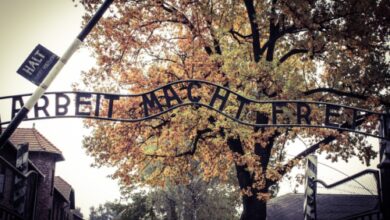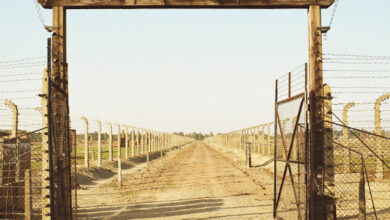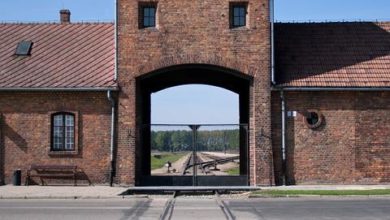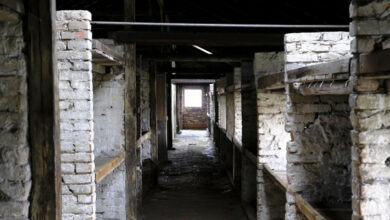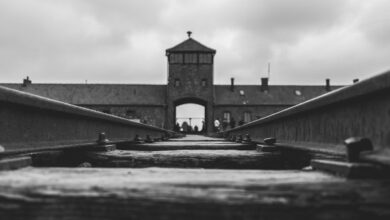Auschwitz-Birkenau is a group of German Nazi concentration camps. The extermination camp operating in the years 1940–1945 in Oświęcim is currently located within the borders of Poland. In this article we will try to shortly describe the history of Auschwitz Birkenau. Nowadays Oświęcim town is located about 70 km from Krakow.

Table of Contents:
A Brief History Of Auschwitz Concentration Camp
At the end of 1939, Arpad Wigand, who served as a police and security inspector, came up with the idea of creating a camp in Oświęcim. Germans name it as Auschwitz. It was caused by overcrowded prisons in Upper Silesia and the Dąbrowa Basin. The place was chosen not accidentally, it had a good rail connection with Austria, the Third Reich and Upper Silesia.
Rudolf Höß On May 4, 1940 was appointed the first commander of the Auschwitz camp. This camp was directly subordinated to the SS board, and from 1942 it was subject to the SS Administration and the Central Office of Economy.
The camp staff changed very often, and it is estimated that over 8100 SSmen appeared in the camp throughout its operation.
Read also:
- Auschwitz Dress Code
- Auschwitz Shuttle – Auschwitz Museum to Kraków
- Auschwitz Tours from Krakow
- Day Trip to Auschwitz from Krakow
- History of Krakow
- Krakow Castles
- Cheapest Auschwitz tour
- Private Auschwitz Tours
- Tickets to Auschwitz
- Warsaw: Full-day Tour to Krakow and Auschwitz by Train
- Weather in Krakow
- Wieliczka Salt Mine Tour
The Auschwitz camp was managed in turn by three commanders:
- Rudolf Höß – 1940-1943
- Arthur Liebehenschel – 1943-1944
- Richard Baer – 1944-1945.

Three parts of Auschwitz Konzentrationslager:
- Auschwitz I – base camp, forced labour, SS management centre.
- Auschwitz II Birkenau – a concentration camp located in Brzezinka, an extermination site where crematoriums and gas chambers were located.
- Auschwitz III – IG Farben labor camp located in Monowice.
Until 1942, most of Poles, as well as Germans, Czechs and Yugoslavs stayed in the camp. From April 1942, the Nazis began to direct transports of Jews from all over Europe. Arrived prisoners were photographed and enlisted in the registry.
As many as 700 prisoners tried to escape from the camp, more then 300 managed to do it and escaped to a safe place.
One of them was Captain Witold Pilecki. Who volunteered to infiltrate the camp in 1940. He escaped from the camp on April 26, 1943 and it was thanks to him that the Allies command learned details about the Auschwitz camp.

During the Eastern campaign in 1944, the Nazis were loosing front, and thus undertook preparations for the liquidation of the concentration camps in August of the same year.
This caused stop of developing next stages of the camp. Then happen evacuation of prisoners to the Third Reich, the liquidation of Sonderkommand members. Then destruction of documentation, and began to blur the traces of crime – pits with debris were filled and one crematorium was demolished.
On January 17, 1945, there were 67 012 people in the camp. Most of them were taken to Germany or Austria in freight wagons under inhuman conditions.
On January 20, 1945 Nazis continued to destroy documents and blew up further crematoria. And on the same day there were only 9,000 prisoners in the camp, of which 500 were children – all who remained in Auschwitz were to be murdered.
As early as January 27, 1945, Soviet soldiers arrived at the camp, freeing 7,500 people from the Nazis.
How many people died in concentration camps
It is estimated that at least 1.5 million people of different nationalities died in the camp – Czechs, Poles, Yugoslavs, Belarusians, French, Russians, Ukrainians, Albanians, Belgians, Danes, Greeks, Spaniards, Dutch, Lithuanians, Luxembourgers, Latvians, Norwegians , Romanians, Slovaks, Swiss, Hungarian, Italians.

Times after war
Just after liberation of prisoners, Sovied NKVD insert German prisoners in Auschwitz, and they existed until 1946.
Polish government after war, (which was lost for Polish) under Soviet occupation started reconstruction of country. And from 1947 in place of Auschiwtz I and Auschwitz II there was created Auschwitz-Birkenau State Museum. The camp has been preserved forever as the Monument to the Martyrdom of the Polish and other nations.
On 1979 camp became part of UNESCO protection.
